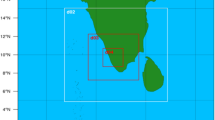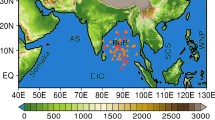Abstract
Orography profoundly influences seasonal rainfall amount in several places in south Asia by affecting rain intensity and duration. One of the fundamental questions concerning orographic rainfall is nature of the associated precipitating clouds in the absence of synoptic forcing. It is believed that these clouds are not very deep, however, there is not much information in the literature on their vertical structure. The present study explores the vertical structure of precipitating clouds associated with orographic features in south Asia using data collected with the precipitation radar on board the Tropical Rainfall Measuring Mission satellite. Two types of precipitating clouds have been defined based on cloud echo top height, namely, shallow echo-top cloud and medium echo-top cloud. In both, radar reflectivity factor is at least 30 dBZ at 1.5 km altitude, and tops of shallow and medium echo-top clouds lie below 4.5 km and between 4.5 and 8 km, respectively. The Western Ghats contains the highest fraction of the shallow echo-top clouds followed by the adjacent eastern Arabian Sea, while the Khasi Hills in Meghalaya and Cardamom Mountains in Cambodia contain the least fraction of them. Average vertical profiles of shallow echo-top clouds are similar in different mountainous areas while regional differences are observed in the medium echo-top clouds. Below 3 km, precipitation liquid water content in medium echo-top clouds is the highest over the Western Ghats and the eastern Arabian Sea. The average precipitation liquid water content increases by \(0.16\,\hbox { gm m}^{-3}\) for shallow echo-top clouds between 3 and 1.5 km altitude, while the corresponding increase for medium echo-top clouds is in 0.05–0.08 \(\hbox { gm m}^{-3}\) range.









Similar content being viewed by others
References
Beard K V and Pruppacher H R 1969 A determination of the terminal velocity and drag of small water drops by means of a wind tunnel; J. Atmos. Sci. 26 1066–1072.
Blyth A M, Cooper W A and Jensen J B 1988 A study of the source of entrained air in Montana cumuli. J. Atmos. Sci. 45(24) 3944–3964.
Bhat G S 2002 Near surface variations and surface fluxes over the North Bay of Bengal during the 1999 Indian Summer Monsoon; J. Geophys. Res. Atmos. 107 4336, https://doi.org/10.1029/2001JD000382.
Bhat G S 2005 Convection inhibition energy of the inversion and the suppressed rainfall over the Arabian Sea during July 2002: Mausam (ARMEX Special Issue) 56 89–96.
Bhat G S 2006 The Indian drought of 2002 – a subseasonal phenomenon?; Quart. J. Roy. Meteorol. Soc. 132 2583–2602.
Bhat G S, Chakraborthy A, Nanjundaiah R S and Srinivasan J 2002 Vertical thermal structure of the atmosphere during active and weak phases of convection over the north Bay of Bengal: Observation and model results; Curr. Sci. 83 296–302.
Bhat G S and Kumar S 2015 Vertical structure of cumulonimbus towers and intense convective clouds over the South Asian region during the summer monsoon season; J. Geophys. Res. Atmos. 120, https://doi.org/10.1002/2014JD022552.
Fabry F and Zawadzki I 1995 Long-term radar observations of the melting layer of precipitation and their interpretation; J. Atmos. Sci. 52 838–851.
Francis P A and Gadgil S 2006 Intense rainfall events over the west coast of India; Meteorol. Atmos. Phys. 94 27–42, https://doi.org/10.1007/s00703-005-0167-2.
Ghosh S K Pant M C and Dewan B N 1978 Influence of the Arabian Sea on the Indian summer monsoon; Tellus 30 117–125.
Green D R and Clark R A 1972 Vertically integrated liquid water – a new analysis tool; Mon. Wea. Rev. 100 548–552.
Grossman R L and Durran D R 1984 Interaction of low level flow with Western Ghat mountains and offshore convection in the summer monsoon; Mon. Wea. Rev. 112 652–672.
Heymsfield G M, Tian L, Heymsfield A J, Li L and Guimond S 2010 Characteristics of deep tropical and subtropical convection from nadir-viewing high-altitude airborne Doppler radar; J. Atmos. Sci. 67 285–308.
Houze R A 1993 Cloud dynamics; Academic Press, 496p.
Houze R A 2004 Mesoscale convective systems; Rev. Geophys. 42, https://doi.org/10.1029/2004RG000150.
Houze R A Jr, Wilton D C and Smull F B 2007 Monsoon convection in the Himalayan region as seen by the TRMM precipitation radar; Quart. J. Roy. Meteorol. Soc. 133 1389–1411.
Houze R A 2012 Orographic effects on precipitating clouds; Rev. Geophys. 50 RG1001, https://doi.org/10.1029/2011RG000365.
Houze R A, Rasmussen K L, Zuluaga M D and Brodzik S R 2015 The variable nature of convection in the tropics and subtropics: A legacy of 16 years of the Tropical Rainfall Measuring Mission satellite; Rev. Geophys. 53, https://doi.org/10.1002/2015RG000488.
Konwar M, Das S K, Deshpande S M, Chakravarty K and Goswami B N 2014 Microphysics of clouds and rain over the Western Ghat; J. Geophys. Res. Atmos. 119, https://doi.org/10.1002/2014JD021606.
Kumar S, Hazra A and Goswami B N 2013 Role of interaction between dynamics, thermodynamics and cloud microphysics on summer monsoon precipitating clouds over the Myanmar Coast and the Western Ghats; Clim. Dyn. https://doi.org/10.1007/s00382-013-1909-3.
Kumar S and Bhat G S 2016 Vertical profiles of radar reflectivity factor in intense convective clouds in the tropics; J. Appl. Meteorol. Climatol. 55(5) 1277–1286.
Kumar S 2015 A 10-year climatology of vertical properties of most active convective clouds over the Indian regions using TRMM PR; Theor. Appl. Climatol. 127(1–2) 429–440, https://doi.org/10.1007/ s00704-015-1641-5.
Kumar S 2016 Three dimensional characteristics of precipitating cloud systems observed during Indian summer monsoon; Adv. Space Res. 58(6) 1017–1032.
Kummerow C, Barnes W, Kozu T, Shiue J and Simpson J 1998 The Tropical Rainfall Measuring Mission (TRMM) sensor package; J. Atmos. Oceanic. Technol. 15 809–817.
Marshall J S and Palmer W Mc K 1948 The distribution of raindrops with size; J. Meteorol. 5(4) 165–166.
Maheskumar R S, Narkhedkar S G, Morwal S B, Padmakumari B, Kothawale D R, Joshi R R, Deshpande C G, Bhalwankar R V and Kulkarni J R 2014 Mechanism of high rainfall over the Indian west coast region during the monsoon season; Clim. Dyn. 43(5–6) 1513–1529.
Mukherjee A K, Rao M K and Shah K C 1978 Vortices embedded in the trough of low pressure off Maharashtra–Goa coasts during the month of July; Indian J. Met. Hydrol. Geophys. 29 61–65.
Oruga Y and Yoshizaki M 1988 Numerical study of orographic–convective precipitation over eastern Arabian Sea and the Ghat mountains during the summer monsoon; J. Atmos. Sci. 45 2097–2121.
Rao Y P 1976 Southwest monsoon; India Meteorological Department.
Romatschke U, Medina S and Houze R A 2010 Regional, seasonal, and diurnal variations of extreme convection in the south Asian region; J. Clim. 23 419–439
Romatschke U and Houze R A Jr 2011 Characteristics of precipitating convective systems in the south Asian monsoon; J. Hydrometeorol. 12 3–26.
Sarker R P 1967 Some modification in a dynamical model of orographic rainfall; Mon. Wea. Rev. 95 673–684.
Sherwood S C, Minnis P and McGill M 2004 Deep convective cloud-top heights and their thermodynamic control during crystal-face; J. Geophys. Res. 109, https://doi.org/10.1029/2004JD004811.
Shrestha D, Deshar R and Nakamura K 2015 Characteristics of summer precipitation around the Western Ghats and the Myanmar West Coast; Int. J. Atmos. Sci., https://doi.org/10.1155/2015/206016.
Ulbrich C W and Atlas D 1998 Rainfall microphysics and radar properties: Analysis methods for drop size spectra; J. Appl. Meteor. 37 912–923.
Xie S P, Xu H, Saji N H, Wang Y and Liu W T 2006 Role of narrow mountains in large-scale organization of Asian monsoon convection; J. Clim. 19(14) 3420–3429.
Yuter S E and Houze R A Jr 1995 Three-dimensional kinematic and microphysical evolution of Florida cumulonimbus: Part II. Frequency distribution of vertical velocity, reflectivity, and the differential reflectivity; Mon. Wea. Rev. 123 1941–1963.
Acknowledgements
This work was supported by grants from the Department of Science and Technology, New Delhi, and the Ministry of Earth Sciences, New Delhi. TRMM data are provided by NASA’s Earth–Sun System Division. The radiosonde data used in the work were taken by the India Meteorological Department and downloaded from the University of Wyoming website.
Author information
Authors and Affiliations
Corresponding author
Additional information
Corresponding editor: Ashok Karumuri
Rights and permissions
About this article
Cite this article
Kumar, S., Bhat, G.S. Vertical structure of orographic precipitating clouds observed over south Asia during summer monsoon season. J Earth Syst Sci 126, 114 (2017). https://doi.org/10.1007/s12040-017-0897-9
Received:
Revised:
Accepted:
Published:
DOI: https://doi.org/10.1007/s12040-017-0897-9




